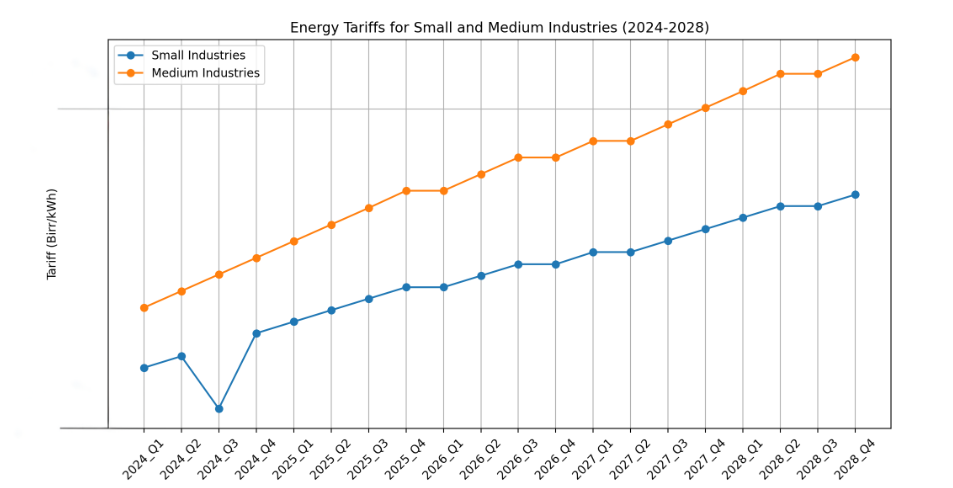Introduction
The Ethiopian Energy Utility’s announcement of a significant electricity tariff hike, effective from July 2024 to 2028, represents a transformative shift in the country’s energy policy. This adjustment affects all consumer categories, with particular emphasis on the manufacturing sector, which underpins Ethiopia’s industrial and economic growth. This article provides a scientific analysis of the projected tariff escalation, its sectoral impacts, and the strategic pathways necessary to address these challenges.
Economic and Technical Context
Ethiopia’s manufacturing sector, a critical driver of industrialization, is heavily reliant on electricity to power its operations. The proposed tariff increases—graduated based on consumption levels and sector—pose significant challenges to industrial stakeholders. The steep increments for medium and large-scale industries necessitate a thorough assessment of their impacts on production costs, energy efficiency, and economic viability.
The graphical data, spanning from July 2024 to 2028, unveils a consistent upward trajectory in tariffs. This trend underscores the increasing cost of energy and its implications for Ethiopia’s economic landscape, calling for strategic adaptation and mitigation measures.
Temporal and Sectoral Dynamics of Electricity Tariffs
The accompanying graphs provide critical insights into the tariff trends:
Figure 1.1 Longitudinal Trajectory of Electricity Tariffs (2024–2028) (Source :Ethiopian Electric Utility)
The graph illustrates a steady increase in electricity costs across all sectors, with manufacturing industries experiencing the highest surges. This rise reflects the policy’s intent to address energy subsidies while promoting efficient energy use. Residential consumers, subject to tiered pricing, face moderated increases compared to industrial users.

Figure 1.2 : Quarterly Variations in Tariffs for Industrial Sectors (2024–2028) (Source :Ethiopian Electric Utility)
Seasonal fluctuations are evident, with tariff peaks during high-demand periods such as summer. Medium-sized industries bear the brunt of these increases, highlighting their exposure to pricing volatility. This temporal variability necessitates proactive energy management and operational adjustments to mitigate financial strain.
Scientific Insights and Strategic Implications
The escalating electricity tariffs present a dual challenge of rising operational costs and heightened urgency for energy efficiency within Ethiopia’s manufacturing sector. These dynamics compel stakeholders to consider innovative solutions to mitigate the economic impact while aligning with sustainability goals.
The analysis reveals that renewable energy sources, such as hydroelectric power, offer greater tariff stability compared to fossil fuel-dependent electricity, which is subject to market-driven volatility. This finding underscores the strategic advantage of investing in renewable energy technologies to stabilize energy costs and promote long-term sustainability.
From a policy standpoint, the evolving tariff structure necessitates regulatory measures to cushion the financial impact on industries and consumers. Policymakers must prioritize the development of frameworks that promote equitable energy transitions and incentivize energy-efficient practices.
Pathways for Mitigation and Adaptation
To address the challenges posed by the tariff escalation, the following strategies are recommended:
- Deployment of Advanced Energy Management Systems (EMS): Industries should adopt EMS to optimize electricity consumption, reduce wastage, and enhance overall efficiency.
- Investment in Renewable Energy Solutions: Embracing solar, wind, and other renewable energy technologies can mitigate dependency on grid electricity and reduce exposure to tariff volatility.
- Adoption of Demand-Side Management (DSM): Aligning energy use with off-peak hours can lower costs and support grid stability.
- Policy Interventions: Targeted subsidies, concessional financing, and technical support for energy-efficient practices can alleviate the economic burden on industries.
In conclusion, the electricity tariff hike in Ethiopia presents a classic example of the delicate balance between fiscal sustainability and economic growth. While the policy may aim to improve utility performance and reduce subsidies, its repercussions on the manufacturing sector and broader economy necessitate careful reconsideration. Mitigation strategies, supported by evidence-based policymaking and stakeholder engagement, are essential to prevent the exacerbation of socioeconomic vulnerabilities.









